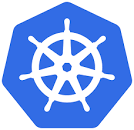
Kubernetes has become a leading container orchestration platform, powering the deployment, scaling, and management of containerized applications. The Kubernetes logo, featuring a ship’s wheel, has become synonymous with this powerful technology. In this blog article, we’ll delve into the symbolism and design philosophy behind the Kubernetes logo, exploring the connections between the project’s mission and its visual representation.
-
The Kubernetes Name and Its Nautical Origins
The name Kubernetes originates from the Greek word “κυβερνήτης” (kyvernitis), meaning “helmsman” or “pilot.” This nautical reference is a nod to the project’s goal of guiding and managing containerized applications, much like a helmsman navigates a ship.

-
The Ship’s Wheel: Steering Containers in the Right Direction
The Kubernetes logo features a ship’s wheel, further emphasizing the project’s nautical roots. The wheel symbolizes Kubernetes’ role in orchestrating containerized applications, steering them in the right direction, and ensuring their smooth journey through the development and deployment lifecycle. The wheel also represents the platform’s ability to manage multiple containers simultaneously, much like a helmsman skillfully navigates a ship through turbulent waters.
-
The Seven Spokes: Reflecting Kubernetes’ Core Principles
The ship’s wheel in the Kubernetes logo comprises seven spokes, which represent the core principles that drive the project’s development:
- Scalability: Kubernetes is designed to manage thousands of containers, ensuring consistent performance as your applications grow.
- Portability: Kubernetes can run on various platforms, from public clouds to on-premises data centers.
- Extensibility: Kubernetes supports a rich ecosystem of tools and plugins, making it easy to integrate with existing workflows and technologies.
- Resilience: Kubernetes is built to handle failures gracefully, ensuring high availability and minimizing downtime.
- Declarative Configuration: Kubernetes uses a declarative approach, allowing developers to describe the desired state of their applications and letting the platform manage the rest.
- Automation: Kubernetes automates repetitive tasks such as deployment, scaling, and updates, allowing developers to focus on writing code and delivering features.
- Community: Kubernetes is an open-source project backed by a vibrant and diverse community, driving innovation and collaboration.
-
The Color Palette: Representing Kubernetes’ Open-Source Nature
The Kubernetes logo uses a combination of blue and white colors, which symbolize the project’s open-source nature. Blue is often associated with trust, stability, and reliability, while white represents simplicity and transparency. The color palette reflects Kubernetes’ commitment to providing a dependable, easy-to-use platform that is open, accessible, and collaborative.
-
Designing Your Kubernetes-Themed Artwork
Inspired by the Kubernetes logo? You can create your Kubernetes-themed artwork or swag using the official logo assets provided by the Kubernetes community. Be sure to adhere to the Kubernetes brand guidelines (https://github.com/kubernetes/community/tree/master/logos) to maintain the project’s visual identity and promote a cohesive brand image.
Check out more great articles related to Kubernetes from our Kubernetes articles page!
Frequently Asked Questions
Here are some common questions related to Kubernetes, its logo, and usage:
What is the Kubernetes logo?
The Kubernetes logo features a ship’s wheel, representing its role in navigating and managing containerized applications. The wheel has seven spokes and a stylized letter “K” in the center. For more information on the Kubernetes logo, visit Kubernetes Logo.
Why is Kubernetes called K8s?
Kubernetes is often referred to as K8s, where the number 8 represents the eight letters between the first “K” and the last “s” in the word “Kubernetes.”
Is Kubernetes and K8s the same thing?
Yes, Kubernetes and K8s are the same thing. K8s is just a shorthand representation of the word Kubernetes.
What does the Greek word Kubernetes mean?
Kubernetes is derived from the Greek word “κυβερνήτης,” which means helmsman or pilot. It represents the platform’s ability to navigate and manage containerized applications.
Why is Kubernetes so famous?
Kubernetes gained popularity due to its robust container orchestration capabilities, scalability, and versatility in managing containerized applications. It has become the de facto standard for container orchestration and enjoys strong community support and a rich ecosystem of tools and services.
Is Kubernetes owned by Google?
Kubernetes was originally developed by Google and later donated to the Cloud Native Computing Foundation (CNCF), which now maintains the project. Although Google is still an active contributor, Kubernetes is an open-source project with contributions from many organizations and individuals.
Does NASA use Kubernetes?
Yes, NASA uses Kubernetes for various projects, including the Mars Rover mission, where they leveraged Kubernetes to manage the cloud infrastructure required for data processing and analysis.
Is Amazon using Kubernetes?
Yes, Amazon uses Kubernetes and also offers a managed Kubernetes service called Amazon Elastic Kubernetes Service (EKS). This service simplifies the deployment, management, and scaling of Kubernetes clusters in the AWS cloud.
Conclusion
The Kubernetes logo is more than just a visual representation; it embodies the project’s mission, core principles, and commitment to the open-source community. By understanding the symbolism and design philosophy behind the Kubernetes logo, we can better appreciate the platform’s dedication to orchestrating containerized applications and fostering a collaborative, innovative ecosystem. As you navigate the world of container orchestration, let the Kubernetes logo serve as a reminder of the values and principles steering your journey.







